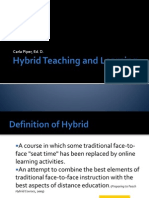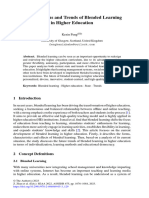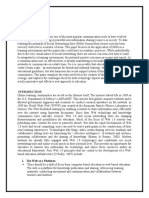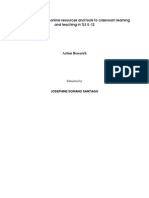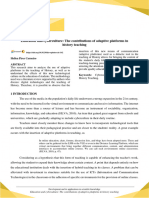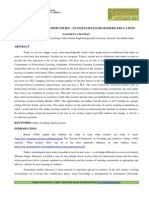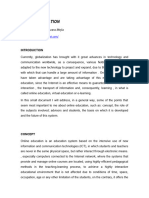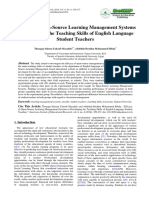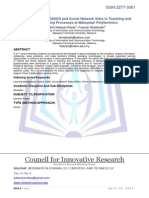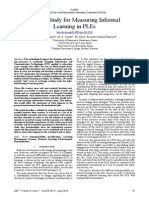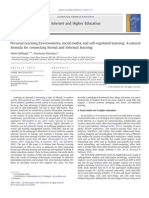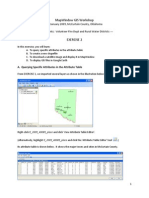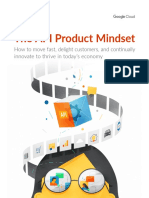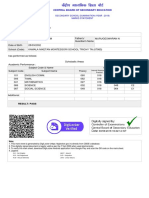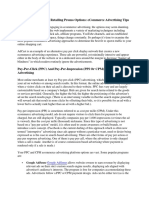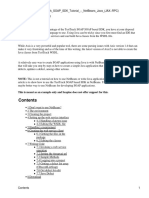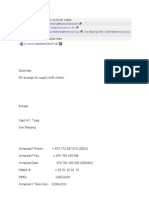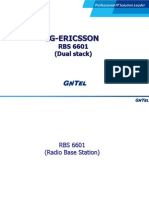Agregacion de Contenido e Intercambio de Conocimiento en Los PLE
Agregacion de Contenido e Intercambio de Conocimiento en Los PLE
Uploaded by
Ederson ElcorelCopyright:
Available Formats
Agregacion de Contenido e Intercambio de Conocimiento en Los PLE
Agregacion de Contenido e Intercambio de Conocimiento en Los PLE
Uploaded by
Ederson ElcorelOriginal Description:
Original Title
Copyright
Available Formats
Share this document
Did you find this document useful?
Is this content inappropriate?
Copyright:
Available Formats
Agregacion de Contenido e Intercambio de Conocimiento en Los PLE
Agregacion de Contenido e Intercambio de Conocimiento en Los PLE
Uploaded by
Ederson ElcorelCopyright:
Available Formats
SPECIAL FOCUS PAPER
CONTENT AGGREGATION AND KNOWLEDGE SHARING IN A PERSONAL LEARNING ENVIRONMENT: SERENDIPITY IN OPEN ONLINE NETWORKS
Content Aggregation and Knowledge Sharing in a
Personal Learning Environment: Serendipity in
Open Online Networks
http://dx.doi.org/10.3991/ijet.v8iS1.2362
M. Saadatmand and K. Kumpulainen
University of Helsinki, Helsinki, Finland
Abstract Web 2.0 tools and emerging technologies offer
learners an abundance of information and resources. This
brings more flexibility and choices for learners to better
control their learning and benefit from the various available
learning materials in different forms. This has resulted in
new learning practices and environments in higher
education which are more open, flexible, and studentcentered. Personal Learning Environment (PLE) is such a
technology-mediated and learner-controlled learning
environment. This paper describes PLE as a set of learnerdefined tools and services in the ecology of Web 2.0 used by
participants in three open online courses. The aim of the
study was to find out how participants create and utilize
their PLEs for searching, aggregating, creating and sharing
content and learning resources, and being engaged in online
learning networks and communities. A particular interest
was to explore how serendipity, as a by-product of these
open online encounters, can occur. Data were gathered
through an online survey, semi-structured interviews, and
online artifacts. The findings suggest the serendipitous
nature of content aggregation in a PLE and provide
evidence of serendipity as a valuable and unexpected source
for learning.
Index Terms Content aggregation, MOOC, open courses,
personal learning environment, serendipity.
I. INTRODUCTION
The rise of social media and networked technologies
and the emergence of free/open software have influenced
forms of communication and interaction in the current era.
Such emerging technologies are becoming more
commonplace in everyday life and especially in learning
practices which can offer new learning opportunities at all
levels of education, particularly in higher education.
Technologies which enable distributed collaboration and
global learning experiences challenge predominant
pedagogical and offer the potential for pedagogical
innovation [1]. Such novel technologies offer new ways
of learning, interaction and communication addressing the
needs and requirements of web generations which demand
new literacies and skills for learners in the twenty-first
century.
With the advancement of Web 2.0 and yet other
generations of Web (Semantic Web, Web 3.0, or Web X)
[2] and their applications for learning, students can create
and form learning spaces for themselves which are more
personalized and learner-centered and give more
flexibility and autonomy for them to control their learning.
70
In the area of technology-enhanced learning and online
education, this has resulted in the development of
discourses that address the departing from institutionalized
learning systems to the more student-centered learning
environments known as personal learning environments
(PLE) [3] [4].
Personal learning environments, as understood in this
paper, refer to a combination of social media-enabled
systems, applications, and services which help learners to
take control of their learning by aggregating,
manipulating, and creating digital contents and learning
artifacts, and sharing them with others. The nature of
learning, information aggregation, content creation and
sharing knowledge in such environments is different from
traditional structured models. Students are surrounded by
different tools and resources in different forms and
repositories, and this abundance has influenced learning
behavior to new and complete different ways [5].
Research on PLE and its conceptualization has gained
interest in e-learning mainly after the emerging new
generation of Web 2.0 technologies such as social
networking tools, wikis, blogs, micro-blogging and
social-bookmarking tools [3] [6] [9].
The research described in this paper investigated the
nature of learning and interactions in open online courses
in terms of online tools and services used by the
participants. We explored participants experiences,
challenges and opportunities with online technologies in
the process of learning, interaction, knowledge creation
and sharing in three open online courses where various
web 2.0 tools and social networking tools were deployed
by instructors and learners. The purpose was to find out
how participants of open online courses make use of tools
like microblogging, social bookmarking, networking sites,
and other free/open applications for seeking, aggregating,
creating, and sharing content, and how all these activities
and conditions may foster the processes of serendipitous
discoveries.
II. CHANGING THE CONTEXTS FOR LEARNING
As long as learning and working environments are
being transformed by a variety of emerging technologies,
educational institutions are facing challenges in delivering
their programs and courses. Technology brings new
possibilities for learning, including changes in learning
spaces and infrastructures, new ways of interaction and
collaboration, and new demands for institutional
regulations that adapt to better embrace these
developments. Learning does not just take place inside the
http://www.i-jet.org
SPECIAL FOCUS PAPER
CONTENT AGGREGATION AND KNOWLEDGE SHARING IN A PERSONAL LEARNING ENVIRONMENT: SERENDIPITY IN OPEN ONLINE NETWORKS
formal classroom with planned activities but, a growing
interest towards mobile and ubiquitous learning and
student-led activities outside the formal learning
boundaries. This enhances learning experiences through
exploration (by seeking and experiencing things in various
contexts), interaction (through connection with peers and
experts), and serendipity (searching for knowledge took
place as by-product of the main task in unplanned and
unexpected ways) [10].
Perhaps more than any time in history we have now
access to more information, resources and networks which
make our life more enriched in many ways. In addition to
the benefits it may bring to us, the challenges are also
notably to be considered in terms of schooling, learning
and delivery of instruction [11]. Interestingly, schools
have tried to change. Pedagogy has offered alternative
frameworks for approaching learning for generations, but
the aspects of the traditional educational model that are
premised in scarcity have proven deeply resilient and selfreplicating (P.3).
Institutional change is an issue [12] in order to
encompass these transformations, but so far there
universities and educational institutions have not kept up
with all these rapid technological opportunities to be
innovative and more effective in their practices. We are
not so much depending on classroom and teachers as the
major sources of knowledge as it used to be, and we are
no longer dependant on libraries in their traditional
concept but rather on digital databases and online
repositories. Although, these could be considered as
resources and opportunities, they also bring challenges to
the traditional notion and learning and instruction. So,
there are some technological, pedagogical and cultural
challenges embedded in todays learning practices that can
require some alternatives in designing the curriculum,
learning spaces, and other relevant infrastructures. Maybe
one way looking at learning environments is that there is
a need for a shift from a monolithic learning environment
in which everything must be controlled and predictable to
a more pluralistic learning ecology in which both
prescriptive and emergent application domains and modes
of learning have their places [12, p. 55].
With the fact that the level of engagement of higher
education students in Web 2.0 and social networking tools
is growing [13], and they have become more reliant on
these pervasive technologies both in everyday life,
learning and interaction, the relevant pedagogies should
thus be tuned to the current trends and technologies [14].
Such pedagogies should make learning become more
personalized, networked, and distributed [7] [15] [16]
[17]. Recent and ever-growing transformations of learning
environments signal for new pedagogical challenges and
to the need for a paradigm shift from institutionalized
learning environments to more personalized and flexible
learner-centered learning spaces. The discourse about PLE
is perhaps a response to these technological and
pedagogical requirements that demonstrate a (not
necessarily positive tension) between institutional control
and learner autonomy.
III. PERSONAL LEARNING ENVIRONMENTS
Conversation and research on personal learning
environments in the current definition based on the
development and potential of Web 2.0 and emerging
technologies is rather young and dates back to less than a
iJET Volume 8, Special Issue 1: "ICL2012", January 2013
decade ago. In 2005, Downes [4] referred to E-learning
2.0 to imply the affordances that web 2.0 tools and social
media provide for more participatory learning. Since then,
there has been attention about how to deploy these
affordances to transform learning processes and
environments and concerning the pedagogies needed to
develop flexible, student-centered learning environments.
Kop [18] explains that learning technologists started the
research, design and development of personal learning
environments that could include predictive technologies to
help learners manage their learning in an open networked
environment.
Although, there seems to be no common definition of
PLE among researchers, especially from the point of view
of learners, the notion of PLE is a metaphor that emerged
from such endeavors to emphasize, on one hand, the
learners increased control of the learning process [19]
[20] and for managing their own learning environment
and, on the other hand, the potential of Web 2.0
technologies [4] [13] [15] [21]. The definition of PLE is
based on the development of social software applications,
Web 2.0 capabilities and a shift from the consumers to
prosumers [20]. PLE approach is concerned with
changes from the learners role in the process of learning,
personalization of tools and resources, social engagement
and self-organization of learning and technological
aspects of social software tools and aggregation of
multiple resources (p.4). We agree with [7] on their
definition of PLE that it is not only a personal space but
also a social landscape that offers means to connect with
other personal spaces in order to leverage knowledge
within open and emergent knowledge ecologies which is
open, distributed, diverse, emergent, and learnercontrolled.
PLEs have been of interest to many researchers, and
developers of technology enhanced learning research have
examined
the
technological
and
pedagogical
considerations of such environments in order to
conceptualize the innovative learning practices that are
supported by the new emerging technologies (see [3] [5]
[9] [13] [15] [19]). Anderson [22] has made distinctions
between Learning Management System (LMS) and PLE
and points out that PLEs allow for customization and
personalization and interoperability among different
applications which promote information flow. Personal
learning environments are potentially promising such
pedagogical approaches to connect informal and formal
learning using social media which can support selfdirected learning. They are built on Web 2.0 tools and
services and have the potential to help students aggregate,
create, and share content and resources, participate in
collective knowledge generation, and connect to wider
global learning networks [19].
A concept that is close to PLE is Personal Learning
Network (PLN). Many people may think these two terms
have the same definition, but some researchers make a
distinction between them. For instance Wheeler [23]
describes PLE as a wider framework which encompass a
personal learning network and personal web tools. He
defines PLN as people and groups with which we connect
through social networks, but PLEs are wider and can
include our experiences and learning through other tools,
such as TV, radio, and print materials etc. Personal web
tools in this framework are those usually web 2.0 tools
which are used by a user to support lifelong learning. Mott
71
SPECIAL FOCUS PAPER
CONTENT AGGREGATION AND KNOWLEDGE SHARING IN A PERSONAL LEARNING ENVIRONMENT: SERENDIPITY IN OPEN ONLINE NETWORKS
[24] also sees PLN inside a PLE and states that
institutions, teachers, and learners are increasingly turning
to the open architecture and customizability of the web
and leveraging the tools and resources of the larger PLE to
create their own personal learning networks (PLNs). Mott
further explains that whatever term we use, PLEs or
PLNs, despite any distinction these approaches represent a
shift from a model where students consume information to
a model where students draw connections from a growing
matrix of resources that they select and organize [24]. In
this paper we do not tend to extend the argumentation
about the distinction between PLE and PLN rather, as in
[23] & [44] we also see PLN as persons networks and
connections and as a component of a PLE.
IV. ABUNDANCE, SERENDIPITY AND LEARNING
Technology is an enabler for bringing multiple
opportunities of resources for learning, connections, and
other forms of rich interactions that can promote and
extend learning experiences in many ways. Arnold [25]
utilized the metaphor cabinet of curiosities to point to
the value of WWW as it provides great opportunities for
learning and research. Being immersed in the abundance
of web resources and repositories, creating and sharing
knowledge in different platforms and connections, and
communication by available online tools can bring
unexpected and unplanned learning discoveries that might
link to a meaningful learning. The abundance, diversity
and connectivity make learning enriched and even in
unprecedented ways when individuals are involved in
diverse repositories and resources and connected to many
networks and groups.
The resulting whole of these processes promotes the
possibility of unexpected incidents that can be very
valuable for them. This process of unplanned discoveries
and interactions is so called serendipity [26] [27] [28].
We consider serendipity as valuable unexplored sources
for learning which can be fostered through more
connectivity and engagement by online tools and
networks. Serendipity is not something new in the history
of science and human creativity. Many important
scientific discoveries have been made serendipitously. For
instance, Flemings discovery of Penicillin, Newtons
theory of gravity, or Archimides Bouncy Principle are
such a cited serendipitous discoveries in the literature of
science [26] [29].
The
word
serendipity
was
coined
by Horace Walpole derived it from the Persian fairy tale
'The Three Princes of Serendip' (based on the life of
Bahram Gur, king of Persia [ca. 418-38 A.D.] as described
in Firdausis epic Shahnamah [29]), whose heroes were
always making discoveries by accidents [18]. Serendipity
is defined as unexplored and unplanned discoveries and
fortunate incidents in the process of exploring something
else [26] [28] [30]. Buchem argues that serendipitous
learning emphasizes the role of unexpected realization of
hidden, seemingly unrelated connections or analogies for
learning and research [26]. An important component of
this would be sagacity as the ability to connect
unconnected facts in coming to a valuable conclusion
[27].
Buchem further discusses that surprising
information and unexpected social relationships can lead
to meaningful learning and enhance exploratory behavior:
The term serendipitous learning has been used to refer
to learning through gaining new insights, discovering interesting
72
aspects and recognizing new relations which occur by chance.
The idea of learning through exploration and discovery guided
by a personal set of skills, interests and goals is of course not
new and is closely related to a number of pedagogical
approaches and learning theories, among others discovery
learning (e.g. Bruner, 1961), exploratory learning (e.g. Riemann
et al., 1996), experiential learning (e.g. Kolb, 1984),
constructivist learning (e.g. Jonassen, 1991) and connectivism
(e.g. Siemens, 2005) [26, pp. 2-3].
Bowles states that serendipitous learning identifies that
searching for knowledge may happen as a by-product of
the main task [28]. For example, a search for information
may launch the user off on a tangent that ends up being
more productive than the original search query. In such
instances serendipitous learning has taken place (p.5).
Although Foster & Ford [30] assert that serendipity is a
difficult term to research and still is a relatively fuzzy
concept but, it is important across disciplines especially in
the literature of information retrieval and information
seeking. We argue that in open online learning contexts
where learners are involved in a variety of resources and
activities, the processes of serendipitous learning are more
probable and can be valuable for learners to open new
directions and insights for their learning and interactions.
Serendipity would seem to be important across
disciplinary areas for its role in connection building,
discovery and creativity. The literature of information
seeking has also provided some support for the view of
serendipity as a purposive or active phenomenon [30]. It is
very likely in the process of information seeking on the
web where people immerse themselves in the digital
information spaces that a person comes up with some
unexplored, incidental and yet valuable discoveries. It
may result in the acquisition of new information or an idea
related or not to a planned query which was the original
intent of the user.
Downes [17] describes characteristics of learning in
open networked environments such as MOOCs (Massive
Open Online Courses) which are autonomy, diversity,
openness, and connectedness. Autonomy allows
learners maximum choice of where, when, how, with
whom and even what to learn. They engage in diverse
readings, discussions and environments. Openness
accommodates all levels of engagement, with no barriers
between in and out. It helps to ensure the free flow of
information through the network, and encourages a culture
of sharing and a focus on knowledge creation.
Connectedness and interactivity is what makes all this
possible [31, p. 267].
In e-learning and online networking, there has been
some research about serendipity; for example, the
potential of micro-blogging tools like Twitter for fostering
serendipitous learning [18] [32] [26]. Reinhardt, Wheeler
and Ebner [32] found that Twitter is a potentially powerful
social networking tool and users discover the serendipity
of the service when they come across unexpected but
extremely useful content that has been sent or re-tweeted
by other users in their network. Kop [18] in a study of
Twitter and RSS in open online courses (MOOCs) found
that it seemed that the more participants have re-tweeted
and used hash-tags and the more the number and spread of
RSS feeds, the higher the likelihood of unexpected and
challenging pieces of information and serendipity have
been. She further argues that serendipity might be
increased through communications with other people; and
that the degree of serendipity may increase in learning
http://www.i-jet.org
SPECIAL FOCUS PAPER
CONTENT AGGREGATION AND KNOWLEDGE SHARING IN A PERSONAL LEARNING ENVIRONMENT: SERENDIPITY IN OPEN ONLINE NETWORKS
network by the level of control over the information
gathering process, the involvement of people, and the
aggregation of information feeds [18].
Buchem [26] argues that the potential of incidental and
serendipitous learning in social networks requires further
conceptualization and more empirical research. In this
study we elaborate on this topic of research and
investigate the nature of serendipitous learning in open
online networks in the context of MOOCs while
participants are engaged in a variety of activities such as
blogging, micro-blogging services, RSS, social
bookmarking and many others.
V.
THE STUDY
A. Aim of the Study and RQs
The aim of this study was to investigate how
participants in open online courses use various Web 2.0
tools and services (defined as PLE in this paper) to search,
aggregate, create, and share information and contents
during the course. One particular interest was to find out
how serendipity might occur in the abundance of
information and resources. The following are the guiding
research questions:
- What constitutes a personal learning environment
for the participants in open online courses?
- How is a personal learning environment utilized
for seeking, aggregating, creating and sharing
contents in open online courses?
- Is any serendipity taking place in the process of
using various Web 2.0 tools and services and, if
so, how?
B. Research Setting, Participants and Data Collection
This study is a qualitative ethnographic research which
adapted online ethnography to discover the actual
activities, learning experiences, and engagements of
participants in open online courses. Online ethnography is
a research methodology that focuses on the complexities
of contemporary, technologically mediated social world
[34]. Online ethnography has been used to study
networking learning phenomena and technology mediated
online practices [33] [35].
The empirical context of this study was open online
courses known as Massive Open Online Courses
(MOOCs) offered by some universities from Canada in
2010 and 2011. The courses were PLENK2010 (Personal
Learning Environments, Networks and Knowledge; a 10weeks open course offered by Athabasca University),
EC&I831 (Social Media and Open Education; a 13-weeks
open course offered by the University of Regina) and
CCK11 (Connectivism and Connective Knowledge; a 12weeks open course offered by the University of
Manitoba). The number of participants for each course
varied from 150 to 1500 and from many countries around
the world. Throughout all these three courses, Twitter
activities, participants and facilitators blogging, Facebook
Groups and other social network interactions developed
around the course subjects [18]. One central resource for
the distribution of course materials was a Daily Newsletter
that aggregated resources and artifacts produced by
participants in their blogs, Twitter or wikis. The level of
participation was varied from lurking to active
participation. That was because these MOOCs were
offered for a few numbers of for-credit students and the
iJET Volume 8, Special Issue 1: "ICL2012", January 2013
rest were taking part as non-credit participants. Those who
were for-credit students were more active and supposed to
produce some assignments but, other could have been
participating in any extent the wish.
Participants of this study were from the three
abovementioned MOOCs. Some of them had been already
participating in other open courses and some other just
participated in one of these MOOCs for the first time.
Data were gathered by an online survey, online semistructured interviews, researchers field notes, and online
artifacts of the participants of the courses. After each
course, a survey was carried out about the participants
activities and experiences during the course. Then twelve
interviews were conducted each lasting from 45 to 80
minutes. Because participants were scattered in different
countries, interviews were done and recorded online using
Skype and Google Talk. Interviewees aged from 25 to 54
from six different counties. I interviewed both for-credit
and not-for-credit participants. Online data included those
kinds of contents that participants produced and shared on
their blogs, Twitter, Facebook, YouTube, as their projects
for the course and their reflections on their learning in the
course. Interviews were transcribed and analyzed using
qualitative analysis techniques.
VI. RESULTS
In an earlier paper we have described the learning
experiences and perceptions of participants in the open
online courses in a broader scale in terms of managing
their learning, general use of the online tools, and
opportunities and challenges in such open networked
learning environments [36]. In this paper we aimed to
focus in more depth on the nature of content aggregation,
creating and sharing knowledge and serendipity as a
source for learning (all as defined in the previous
discussion). These involve learning that happens in the
open online courses we studied that had a large number of
participants.
A. Creating a PLE in Open Online Courses
Earlier we discuss that the notion of PLE does not
connote the same definition for all researchers, nor does it
have the same meaning even to users. It depends on the
situation, learning goals, personal preferences, and the
students level of technological competency. The latter
seems to be crucial to how a PLE is created by a user.
One participant answers that a PLE include: The
collection of tools that I use to process web-based
information: includes Twitter, Tumblr, Google Reader,
Flickr, Slideshare, email. Similarly another one explains
it as a range of tools to connect with people and
resources and conversations you know ... I see my PLE as
various technologies in terms of process and
organization. The leverage of technology application and
competency needed for developing a PLE as a hub for
learning is another important issue: My technological
competency is pretty good, and the efficiency improves if
I use the tool a lot. Thus, the level of competency and the
frequency of using the tools influence how a PLE is
developed. Because, for instance, this user had enough
knowledge for using and applying tools in the process of
learning, her PLE would be different and consists of many
more tools than someone who does not know how to use a
tool effectively. She further confides, I wasnt that
competent in those stuff, I was not that good user of them
73
SPECIAL FOCUS PAPER
CONTENT AGGREGATION AND KNOWLEDGE SHARING IN A PERSONAL LEARNING ENVIRONMENT: SERENDIPITY IN OPEN ONLINE NETWORKS
so, I didnt know them. This user goes on to reveal that,
while she was not initially familiar with some tools, her
competency in using the tools she needed for learning and
communication had developed in connection with other
users during the course.
PLE is an approach to student-centered learning which
enhances a learners autonomy and flexibility and the set
of applications or tools can be varied depending on the
users choice and preferences, learning goals, and time.
We understood from the participants explanations that
what is more important than just tools and concepts
employed in a PLE is how the user can make sense of
those tools and services and how to apply them in the
process of learning and interaction. It does not necessarily
just consist of Web 2.0 tools or a set of web based
applications, but it can also include other traditional forms
of media or any kind of means such as physical structures:
To me a PLE is just a jargon for the collection of tools and
individual uses to organize resources in a web-based
environment. If you extended its meaning, it would also include
classrooms, television programs, hallway meetings, etc. As a
collection of tools, PLEs have the characteristics of being
controlled by the individual learner, and represent that
individuals approach to material and social or professional.
PLE is not just a personal space but also a social
landscape to promote various networking processes and to
improve how a learner can personalize the sets of tools,
services, and resources. So, various processes might be
promoted through a PLE in open online learning that each
tool can play a role for a process or a combination of
processes through different interconnected applications.
PLE is a place where I share, gather, reflect, discuss,
argue, and contemplate social media in education. I find
that Twitter is the best to talk with people, discover new
resources, read about what other people are doing. A
personal learning environment is basically a networked
hub for accessing, aggregating, creating, and sharing
knowledge. It is a collection of tools and services defined
and applied by a learner in the process of learning. In the
realm of Web 2.0, a PLE usually could be a mash-up of
free/open tools and applications defined and chosen by a
user for specific learning purposes, maybe for a particular
period of time and in a special context or circumstances.
My PLE is my browser in a general sense which I have set up
many plug-ins and tools to keep updated with the information I
am collecting and sending. A web platform which I use for
aggregating the contents from blogs and websites I am
subscribed.
Mash-ups are good solutions for developing a PLE on
the enormity of Web 2.0 sphere for aggregating content
(knowledge pull) to juxtapose content from different
sources (e.g., feeds, widgets, media) into a single interface
(mash-up for aggregation) [7] [21]. Fig. 1 illustrates a
mash-up PLE that can contain an array of different (often
connected) tools and services that a user builds using Web
2.0 potentialities. Tools and applications in such a
personalized learning ecosystem could be connected
through APIs (Application Programming Interfaces) and
user-defined widgets in order to access content in diverse
sources and aggregate them by different means. For
example, social bookmarking tools such as Delicious and
Diigo, RSS reader for getting updates of news and blog
contents, micro-blogging tool such as twitter for sharing
and receiving short messages are some components in a
user-defined PLE. All these tools and services are defined
by and between users. This figure only shows examples
74
of the most popular and commonly used tools by users,
but it could be different for each individual person
according to needs and preferences. A user here explains
how she fetches the tools she needs and for what
purposes:
I use Twitter. I do not have college or personal contacts there. I
use Facebook for real-life friends and people I meet in online
classes. I use my Wordpress blog for communicating my own
ideas and experiences in teaching, both online and on-site.
Google Reader I use for reading blog posts, but its so huge that
I have trouble using it to store things, so I use Diigo for that.
Twitter is part of my PLE but Facebook is not. I use Slideshare
to share presentations from conferences and lectures from
classes. I use Flickr to share photos related to work or classes
Im taking or teaching. I use Diigo to bookmark articles related
to my work, and sources for my classes.
create
access
aggregate
bookmark
APIs
widgets
annotate
connect
share
Figure 1. A mash-up PLE ecosystem
B. Aggregation and Sharing in a Mash-up PLE
Fig.1 convenes a range of processes for learning and
interactions facilitated by different tools in a personal
learning ecology [12] that enable the owner to aggregate
content from different sources, remix, repurpose, and to
create new content and share them through different tools.
Mash-ups or blending together of spaces are reflective and
collaborative spaces that students are becoming familiar
with in online learning [21].
The ability to combine web tools; some blogs for example host
live microblogging feeds (e.g. Twitter stream incorporated into
Blogger) whilst others simply hyperlink to wikis or display
blog rolls a list of links to other blogs the owner reads and
recommends Really Simple Syndication (RSS) feeds for
aggregating content which pushes or feeds notification of web
page updates directly to the subscriber as they occur, usually to
their e-mail account.(p.6)
In a mash-up, tools and services which are used as a
PLE in the open online courses we studied foster the
opportunities for serendipitous discoveries and coming up
with new resources for learning. Fig. 2 shows different
types of notifications, updates and activities in some tools
in a PLE; for instance Google reader, Google Alerts, and
social bookmarking tools Delicious and Diigo that bring
resources and materials for the user. This approach of
collecting different resources inside a PLE provides
updates of the feeds and pulls them together in an easyaccessing way. Some of these resources are those the user
has set to get new updates. For instance, Google Alerts
can be set up for different topics and keywords of interest
to gather related content for a keyword and bring them to
the user at a defined interval schedule. As can be seen in
figure 2, the Daily Newsletter has been one means of
content aggregation used to send the updates and materials
to the participants. In open courses like PLENK10 all of
these feeds were harvested through a platform called
http://www.i-jet.org
SPECIAL FOCUS PAPER
CONTENT AGGREGATION AND KNOWLEDGE SHARING IN A PERSONAL LEARNING ENVIRONMENT: SERENDIPITY IN OPEN ONLINE NETWORKS
gRSSHopper mediated by one of the course facilitators
and sent everyday to the participants emails (shown in
Fig 2.). It was collecting all materials regarding the course
which used the course #hashtag whether in Twitter, blogs,
or wikis. In another course Paper.li was used to syndicate
contents using #hash-tags or keywords to curate the
content and deliver them to the participants in a daily
base. There were many resources related to the subjects of
the course in Diigo and Delicious that were collected and
shared by the course participants and facilitators. All these
ways of content aggregation and sharing provided
participants with such valuable unexplored and
unanticipated resources that they may not have been
intending to use. With such an abundance of information
the flow serendipity emerges and fortifies learning.
updating space with numerous activities by many users,
serendipty is likely to accur that can open up new ways of
discovery for learner. Kop [27] in a study on MOOCs
found that receiving re-tweets heightens serendipity
because these tweets would be provided by contacts of
contacts, yet still be reasonably close to the aggregator.
Fig 4. demonstrates the number of tweets, retweets, and
replies in one of the MOOCs of course related events and
resources. These tweets have been what participants found
interesting which can also contained serendipitous
information in associated links [18].
Figure 3. TweetDeck desktop application which shows notifications
and latest updates
Figure 2. Aggregation and curation of materials in different tools
Some tools seem to have many more capabilities for
fostering serendipity; for instance the RSS and
microblogging tool Twitter have shown in previous
research [18] [26] [32] to have great potential for users to
bring valuable un-searched resources and new connections
to people and networks. Fig 3. Shows TweetDeck, a
desktop application for managing and aggregating feeds
from various social networking tools such as Twitter,
Facebook, Google Plus etc., which is a useful tool for
updating feeds and monitoring the latest activities on
different channels. When the application starts, in the
notification area (right-hand side in Fig 3.), the activties
that have happened and what have been shared in the
channels the user is subscribed to are shown. It also shows
the number of updates to each one of the hash-tags that the
user is following. Employing an application like
TweetDeck has been a useful way to connect with other
people and getting new updates from them as a participant
expressed her own use of it:
I have TweetDeck. I use Twitter because I connect with teacher
in ESL in the whole world and we tweet things we have weekly
discussions on. I attend one of the teachers webinars because of
Twitter, I mean that Twitter introduced me to many things in
this world in my career as a teacher.
By reveiwing all these updates and notifications, a user
can get into a veriety of resources and contents which
have been circulated in different networks and by different
individuals that might or might not necessarily ha e been
originally followed by this user. This promotes the
likelihood of receiving new materials that can have
valuable new insights for the learner. Through these
discoveries a person also develops new connections and
locates new contacts. In such a dynamic and instant-
iJET Volume 8, Special Issue 1: "ICL2012", January 2013
Figure 4. Tweeting in one of the MOOCs [18]
C. Information Flow, Unexpected Connections and
Fostering Serendipitous Learning
The flow of information between various platforms and
applications can prompt various sorts of serendipity for
other users. In the abundance of information in which
people find themselves, many serendipitous moments
happen that can be more valuable than what was at first
intended. This can bring new direction for learning and
connect individuals to other valuable resources of which
they are not otherwise aware. The ability of learners to
connect unexpected and unplanned discoveries to their
goals and planned purposes is a sagacious ability [27] that
makes the connections richer. That is the value of
networked learning that, in addition to planned goals for
learning,
creates
the opportunities for
fostering
serendipitous moments. Such serendipitous discoveries
and interactions are seen as exciting and meaningful, and
it may generate new ideas, new connections and
encourage further exploration that can lead to construction
of new knowledge [26].
Jarche [37] refers to the process of seek-sense-share
to explain multiplicity and the overload of information to
be leveraged in order to maximize use: how a user can
search for information, make sense of it, and then share it.
He then discusses how new ideas and insights can emerge
from this process. The web is a big space for serendipity
and in the realm of social web 2.0 and ubiquitous social
75
SPECIAL FOCUS PAPER
CONTENT AGGREGATION AND KNOWLEDGE SHARING IN A PERSONAL LEARNING ENVIRONMENT: SERENDIPITY IN OPEN ONLINE NETWORKS
technologies, searching for new information enables
possibilities for further discoveries and developing
connections that enhance chances of encountering
different ideas and insights [26]. The power of social
media brings possibilities for learners to pull together and
share information. APIs and widget can support
interconnectivity and allow for better opportunities for
serendipity to happen.
In contrast to being disciplined and conservative,
openness seems to play an important role in nurturing
serendipity. Openness extended to the point where the
notion of discipline could be a hindrance to serendipity
[30 p. 336]. Connectedness and interactivity (i.e. how a
person is connected to different people, networks and
communities) and diversity (i.e. how a person is using
various tools and resources) are both also important
factors in this regard [31]. When individuals engage in a
diverse load of resources and materials available for them
online through different repositories, when they are
connected to many networks and groups, and when they
are open to share their thoughts freely and openly with
others, the whole of these processes promotes the
possibility of unexplored incidents and unpredictable
coincidences that we have described as serendipitous
learning.
Among the four types of serendipity that Henry [38]
describes, social serendipity, and crowd-sourced
serendipity seem to be fostered through the tools and
resources are utilized in a personal learning environment
in open online courses (Fig 1.). Some of our content
discovery nowadays comes from our social online
networks; our friends, networks, and circles. Such
examples are Facebook and Twitter which include friends
and peers with possible common interests who may share
relevant content that are useful for us. Social serendipity is
something that some participants in open online courses
have experienced as result of being connected and it
involves the possibility of such open networked
environments to bring people together.
I think that was the real strength of MOOC that the amount of
emergent learning was huge and there was no way to predict
what's been going to happen. The fact that I wouldnt be
working with different people from different countries if there
would not have been these connections in this course, thats the
possibility with working online which is fantastic, you would
never have got in any other way.
Another participant claimed that MOOC as an open
learning environment enabled him to get some tools to
use as parts of his PLE and to develop connection with
other people:
I havent been tweeting I opened up my Twitter account with
open course PLENK10 and since then you know I am having a
very good experience with Twitter, I really like twitter this is
one of my top tools. I would say and I have got so many
connections, I have got so many resources from the #hash-tags
in Twitter, also very interesting people who I havent event
known before and I havent been familiar with their work.
With crowd-sourced serendipity social bookmarking
tools such as Delicious, Diigo, Digg, etc., become spaces
of discoveries [38]. In the MOOCs we have studied, some
of these tools have been used by the participants for
sharing contents related to their interest and pertinent to
the course subjects (as shown in Fig 2).
76
VII. CONCLUSIONS
In this paper we have presented some opportunities and
challenges for participants in open online courses in
dealing with the abundance of information, tools, and
emerging technologies. The main purpose was to describe
the nature of information aggregation, content creation
and sharing, and interactions, and the value of serendipity
as a source for learning in open networked learning
environments such as MOOCs. In fact, we were interested
in understanding how serendipitous discoveries can occur
while learners immerse themselves in the abundance of
digital content spaces and engage in various online
networks and communities. With the emergence of
open/free applications and social software, learning
environments are becoming more distributed and easily
accessed anytime and anywhere. Kop points out that,
technologies are now available to empower learners to
take control over the information flow and to be proactive
in pursuit of valuable information. For learners to make
the most of emerging technologies they need to take an
active role in shaping their own learning environment and
in controlling information stream and communication
tools [27].
The concept of personal learning environment has
been developed with the Web 2.0. The PLE approach as a
learner-centered paradigm gives more attention to the role
and autonomy of learners in the process of learning to
create, develop and control their own personalized and
customized learning spaces. PLE discourse is getting
more attention in online education in relation to
integrating informal and formal learning mediated by
technological and social infrastructures.
In this paper we discussed some issues regarding the
nature of content aggregation, learners interactions, and
opportunities for fostering learning through serendipitous
discoveries in open online courses; MOOCs,. We
observed serendipity and unexpected discoveries and
connections as valuable sources for learning. The
unpredictability of serendipitous learning makes it
difficult to plan and to foresee its effects; yet some
researchers claim that serendipity is not mere chance but it
can also be designed in order to increase a persons
chance of making fortunate discoveries [39]. Apart from
a few studies on serendipity in online learning contexts
[18] [26] [32], there is little research that explains how
using open online tools and applications--for example
microblogging such as Twitter and social bookmarking
tools--may impact serendipity [18]. It is still an open
agenda for further research to investigate the nature and
real values of such incidental learning and unexplored
discoveries. Also as [18] indicates, it is useful to examine
how to increase serendipity in information flows and how
it could be fostered and heightened in information streams
to help learners in their personal self-directed online
learning.
REFERENCES
[1]
G. Conole, M. de Laat, T. Dillon, & J. Darby, Disruptive
technologies, pedagogical innovation: Whats new findings from
an in-depth study of students use and perception of
technology. Computers & Education, 50, 2008, pp. 511524.
http://www.i-jet.org
SPECIAL FOCUS PAPER
CONTENT AGGREGATION AND KNOWLEDGE SHARING IN A PERSONAL LEARNING ENVIRONMENT: SERENDIPITY IN OPEN ONLINE NETWORKS
[2]
[3]
[4]
[5]
[6]
[7]
[8]
[9]
[10]
[11]
[12]
[13]
[14]
[15]
[16]
[17]
[18]
[19]
[20]
[21]
[22]
[23]
S. Wheeler, The future of learning: web 2.0 and the smart
extended
web.
LearnTEC,
Karlsruhe,
2011.
http://tinyurl.com/68beada [ Mar. 16, 2012].
G. Attwell, The personal learning environments - the future of
elearning? eLearning Papers, 2(1). 2007.
S. Downs, e-Learning 2.0, eLearn Magazine, 2005. Available at:
http://www.elearnmag.org/subpage.cfm?section=articles&article=
29-1
B. Taraghi, M. Ebner, G. Till, Personal learning environment - A
conceptual study, Int. Conf. on Interactive Computer Aided
Learning (ICL 2009), Villach, AT.
M., van Harmelen,
Personal learning environments.
Proceedings of the 6th International Conference on Advanced
Learning Technologies (ICALT'06), 2006, IEEE.
M.A. Chatti, Anggraeni, M. Jarke, M. Specht, and K. Maillet,
PLEM: a Web 2.0 driven Long Tail aggregator and filter for elearning. International Journal of Web Information Systems, vol
6 no. 1, 2010, pp. 523.
S. Downes, Personal learning environments. Keynote
Presentation delivered to Interactive Technology in Education
Conference , April 22, 2010, Hmeenlinna, Finland.
http://www.downes.ca/presentation/245 [Nov. 19, 2010].
S. Wilson, Patterns of personal learning environments.
Interactive Learning Environments, Vol. 16, No. 1, 2008, pp.
1734.
I. Canova Calori,
Awareness for fostering serendipitous
interaction in public intelligent environments. Journal of
Ambient Intelligence and Smart Environments (JAISE), 2(??):8390, 2009.
B Stewart, Digital literacies 101, what MOOCs really teach,
Inside Higher Education. http://tinyurl.com/bwtleek [Nov. 2,
2012].
R. Williams, R. Karousou, & J. Mackness, Emergent Learning
and Learning Ecologies in Web 2.0, International Review of
Research in Open and Distance Learning, 12, 3, 2011, 39-59.
N. Sclater, Web 2.0, personal learning environments, and the
future of learning management systems (Research Bulletin, Issue
13). Boulder, CO: EDUCAUSE Center for Applied Research.
2008
CISCO, Equipping every learner for the 21st century. A white
paper developed by the Centre for Strategic Education, Cisco
Systems, Inc., and McKinsey & Company. 2008. Available:
http://tinyurl.com/cut55l7 [Jan. 13, 2012].
C. McLoughlin, and M. J. W. Lee, Personalized and self
regulated learning in the Web 2.0 era: International exemplars of
innovative pedagogy using social software. Australasian Journal
of Educational Technology, 26(1), 2010, pp. 28-43.
A. Couros, Developing personal learning networks for open and
social learning. In Emerging Technologies in Distance Education,
G. Veletsianos (Ed.), Published by AU Press, Athabasca
University, Edmonton, 2010, pp. 109-128.
S. Downes, Learning networks in practice. in Emerging
Technologies for Learning (David Ley, ed). 2007. NRC 49275.
R. Kop, Information aggregation in networked learning: The
human factor and serendipity. 8th Int. Conf. on Networked
Learning, Maastricht, The Netherlands, April 2-4, 2012.
N., Dabbagh, & A. Kitsantas, Personal Learning Environments,
social media, and self-regulated learning: A natural formula for
connecting formal and informal learning. The Internet and Higher
Education, 15(1),2011, pp. 3-8.
S. Schaffert & W. Hilzensauer, On the way towards personal
learning environments: seven crucial aspects. eLearning Papers
N 9 July 2008 ISSN, pp. 1887-1542.
S. Wheeler, Learning space mashups: combining web 2.0 tools to
create collaborative and reflective learning spaces, Future
Internet. 2009, 1(1), pp.3-13.
T., Anderson, PLEs versus LMS: Are PLEs ready for Prime
time? In: Virtual Canuck Teaching and Learning in a Net-Centric
World. http://tinyurl.com/3x838q [Apr. 7, 2012].
S.
Wheeler,
Anatomy
of
PLE,
http://stevewheeler.blogspot.fi/2010/07/anatomy-of-ple.html [Jul. 3, 2012].
iJET Volume 8, Special Issue 1: "ICL2012", January 2013
[24] J. Mott, Envisioning the post LMS era: the open learning
network, http://www.educause.edu/ero/article/envisioning-postlms-era-open-learning-network [Aug. 19, 2012].
[25] J. Arnold, The WWW cabinet of curiosities: a serendipitous
research tool. Journal of Education and Learning; Vol. 1, No. 2;
2012
[26] I. Buchem, Serendipitous learning: recognizing and fostering the
potential of microblogging. Formare Open Journal, February
2011 Microblogging in Education. Accessed on 2 June 2012
from: http://tinyurl.com/ccycc58 [Jun. 2, 2012].
[27] R., Kop, The unexpected connection: serendipity and human
mediation in networked learning. Educational Technology &
Society, 15 (2), pp. 211.2012.
[28] J. Gritton, Of serendipity, free association and aimless browsing:
Do they lead to serendipitous learning? 2007. Accessed on 15th
May 2012 from: http://bit.ly/nVzteF [May 15, 2012].
[29] T. J. Sommer, "Bahramdipity and nulltiple scientific discoveries."
Science and Engineering Ethics, 2001, 7(1), pp. 77104.
[30] A. Foster, and N., Ford, Serendipity and information seeking: an
empirical study. Journal of Documentation 59(3), 2003, pp. 321340.
[31] J. Mackness, S. Mak & R. Williams, The ideals and reality of
participating in a mooc. Proc. 7th Int. Conf. on Networked
Learning 2010, Edited by: Dirckinck-Holmfeld L, Hodgson V,
Jones C, de Laat M, McConnell D & Ryberg T. pp. 267-274.
[32] W. Reinhardt, S. Wheeler, M. Ebner, "All I need to know about
twitter in education I learned in kindergarten," in Proc. Key
Competencies in the Knowledge Society, 2010, pp.322-332.
[33] G. Conole, Theory and methodology in Networked learning.
Positional paper for the Networked Learning Hotseat debate,
January 2010.
[34] R. V. Kozinets, Netnography: The marketers secret weapon,
how social media understanding drives innovation. 2010.
[35] B. Kieslinger, M. Ebner, A qualitative approach towards
discovering microblogging practices of scientists, Proc. Of Int.
Conf. Interactive Collaborative Learning (ICL), 2011, pp. 51-57.
[36] M. Saadatmand, K. Kumpulainen, Emerging technologies and
new learning ecologies: learner's perceptions of learning in open
and networked environments. Proc. of the 8th Int. Conf. on
Networked Learning 2012 , Edited by: Hodgson V, Jones C, de
Laat M, McConnell D, Ryberg T & Sloep P. pp.xxx-xxx.
[37] H.
Jarche,
From
observation
to
breakthrough.
http://www.jarche.com/2012/10/from-observation-tobreakthrough/ [Nov. 1. 2012].
[38] Henry Nothhaft, Jr. The myth of serendipity, Tech Crunch 2010.
http://techcrunch.com/2010/11/27/myth-serendipity/ [Oct. 23,
2012].
[39] W. Creixell, J. C. Losada, T. Arredondo, P. Olivares and R. M.
Benito, Serendipity in social networks, Networks and
heterogeneous media, Volume 7, Number 3, September 2012 pp.
363-371.
AUTHORS
M. Saadatmand is a PhD candidate at the Department
of Teacher Education, University of Helsinki, Helsinki,
Finland. He has a Masters Degree in educational
technology and currently is finalizing his doctoral thesis
on
open
online
learning.
(mohsen.saadatmand@helsinki.fi).
K. Kumpulainen is a professor at the Department of
Teacher Education, University of Helsinki, Helsinki,
Finland. Before that she has worked as Director at the
Finnish
National
Board
of
Education.
(kristiina.kumpulainen@helsinki.fi).
This work was supported in part by Academy of Finland, MOTIVE
Program. It is an extended and modified version of a paper presented at
the International Conference on Interactive Collaborative Learning
(ICL2012), held 26 - 28 September 2012, in Villach, Austria. Received
15 November 2012. Published as resubmitted by the authors 3 December
2012.
77
You might also like
- Errors and Solutions Archives - SAP PI - PO Blog PDFDocument30 pagesErrors and Solutions Archives - SAP PI - PO Blog PDFSujith KumarNo ratings yet
- E-Learn 2009 ProceedingsDocument5 pagesE-Learn 2009 Proceedingsmakahaz1No ratings yet
- Design and Implementation of A Virtual Classroom SystemDocument6 pagesDesign and Implementation of A Virtual Classroom SystemTolorunleke FakiyesiNo ratings yet
- Hybrid Teaching and LearningDocument61 pagesHybrid Teaching and Learningapi-239062048No ratings yet
- Current Status and Trends of Blended Learning in HDocument9 pagesCurrent Status and Trends of Blended Learning in HPhuong Lien LaiNo ratings yet
- Pedagogical View of E-Learning ActivitiesDocument5 pagesPedagogical View of E-Learning ActivitiesResearch ParkNo ratings yet
- Preparing Teachers To Integrate Web 2.0 in School Practice: Toward A Framework For Pedagogy 2.0Document20 pagesPreparing Teachers To Integrate Web 2.0 in School Practice: Toward A Framework For Pedagogy 2.0RahmawatiNo ratings yet
- Improving Students' Educational Experience by Harnessing Digital Technology - Elgg in The ODL Environment (#271491) - 252210Document13 pagesImproving Students' Educational Experience by Harnessing Digital Technology - Elgg in The ODL Environment (#271491) - 252210Iqra CHARITYNo ratings yet
- Open Educational Resources For Online Language Teacher Training: Conceptual Framework and Practical ImplementationDocument18 pagesOpen Educational Resources For Online Language Teacher Training: Conceptual Framework and Practical ImplementationijiteNo ratings yet
- Teaching With Web 2.0 TechnologiesDocument10 pagesTeaching With Web 2.0 TechnologiesOmar Vicente Garcia SanchezNo ratings yet
- Learner Generated ResourcesDocument5 pagesLearner Generated ResourcesgaryrobertNo ratings yet
- Social Networking For Teaching Learning ProcessDocument4 pagesSocial Networking For Teaching Learning ProcessLubna ZafarNo ratings yet
- Teaching and Learning Techniques For The Online Environment. How To Maintain Students' Attention and Achieve Learning Outcomes in A Virtual Environment Using New TechnologyDocument13 pagesTeaching and Learning Techniques For The Online Environment. How To Maintain Students' Attention and Achieve Learning Outcomes in A Virtual Environment Using New Technologystardust.m002No ratings yet
- Issues and Perspectives in Delivery and Access: Technology Enabled Technical Education in The New Learning ParadigmDocument12 pagesIssues and Perspectives in Delivery and Access: Technology Enabled Technical Education in The New Learning ParadigmsunilkumareceNo ratings yet
- 12 - Luiza Caraivan - BLENDED LEARNING: FROM CONCEPT TO IMPLEMENTATIONDocument8 pages12 - Luiza Caraivan - BLENDED LEARNING: FROM CONCEPT TO IMPLEMENTATIONtopsy-turvyNo ratings yet
- 2024 11 1 4 AbusalemDocument20 pages2024 11 1 4 AbusalemSome445GuyNo ratings yet
- The Importance of Online Resources and Tools To Classroom Learning and Teaching in TLE K-12Document16 pagesThe Importance of Online Resources and Tools To Classroom Learning and Teaching in TLE K-12Rod Rafael De LeonNo ratings yet
- Icbelsh 1004Document6 pagesIcbelsh 1004International Jpurnal Of Technical Research And ApplicationsNo ratings yet
- Chapter 2Document12 pagesChapter 2Jirah DimaculanganNo ratings yet
- Networked Communities: Mary Lamon, Thérèse Laferrière, and Alain BreuleuxDocument21 pagesNetworked Communities: Mary Lamon, Thérèse Laferrière, and Alain BreuleuxBardo RangelNo ratings yet
- Review of The Related Literature and Studies: Web 2.0 ToolsDocument11 pagesReview of The Related Literature and Studies: Web 2.0 ToolsJodalyn TagabNo ratings yet
- EduCamp Colombia Social NetworkedDocument20 pagesEduCamp Colombia Social NetworkedKevin ArdronNo ratings yet
- Instructional TechnologyDocument45 pagesInstructional TechnologyJancy Vincent100% (2)
- Exploring The Use of Digital Library Services in A Blended Learning Environment: A Malaysian Higher Education PerspectiveDocument11 pagesExploring The Use of Digital Library Services in A Blended Learning Environment: A Malaysian Higher Education PerspectiveAsiah AminNo ratings yet
- The Use of Virtual Classrooms in E-Learning: A Case Study in King Abdulaziz University, Saudi ArabiaDocument12 pagesThe Use of Virtual Classrooms in E-Learning: A Case Study in King Abdulaziz University, Saudi ArabiaShyden Taghap Billones BordaNo ratings yet
- Education and Cyberculture The Contributions of AdDocument9 pagesEducation and Cyberculture The Contributions of AdDorcas WeberNo ratings yet
- The Use of Social Networking Platforms As New, Efficient Technology Tools For E-LearningDocument7 pagesThe Use of Social Networking Platforms As New, Efficient Technology Tools For E-LearningIOSRJEN : hard copy, certificates, Call for Papers 2013, publishing of journalNo ratings yet
- Embodying The Educational InstitutionDocument20 pagesEmbodying The Educational InstitutionjournalijeNo ratings yet
- 1.humanities ONLINE LEARNING COMMUNITIES - An Initiative For Modern EducationDocument8 pages1.humanities ONLINE LEARNING COMMUNITIES - An Initiative For Modern EducationImpact JournalsNo ratings yet
- Online Education EssayDocument5 pagesOnline Education EssayScribdTranslationsNo ratings yet
- File5 ExploringBlendedLearninginAcehDocument17 pagesFile5 ExploringBlendedLearninginAcehKhanh Nguyễn Thị HồngNo ratings yet
- ContentServer PDFDocument10 pagesContentServer PDFCANDYPANo ratings yet
- The Definitionof Blended Learningin Higher EducationDocument19 pagesThe Definitionof Blended Learningin Higher EducationngocvosacNo ratings yet
- Online LearningDocument11 pagesOnline LearningSteven WaruwuNo ratings yet
- Making Mlearning Work: Utilizing Mobile Technology For Collaboration, Assessment, and Reflection in Higher Education - Fisher & BairdDocument29 pagesMaking Mlearning Work: Utilizing Mobile Technology For Collaboration, Assessment, and Reflection in Higher Education - Fisher & BairdDerek E. Baird100% (1)
- Efficacy of Open Source Learning ManagemDocument9 pagesEfficacy of Open Source Learning Managemnandaas887No ratings yet
- Blended LearningDocument10 pagesBlended LearningDaryll Jim AngelNo ratings yet
- Integration of Web 2.0 Tools in Learning A Programming CourseDocument7 pagesIntegration of Web 2.0 Tools in Learning A Programming CoursemonangfransiskusNo ratings yet
- Applicability of Information and Communication Technologies: Tics in The Teaching-Learning Process of Environmental EducationDocument10 pagesApplicability of Information and Communication Technologies: Tics in The Teaching-Learning Process of Environmental EducationIJAERS JOURNALNo ratings yet
- IntroducingSOLEinHEforLLL DefinitiveDocument11 pagesIntroducingSOLEinHEforLLL DefinitiveYusufajri Adrian PBJPNo ratings yet
- Internet Based E-Learning, Pedagogy and Support Systems: Torstein RekkedalDocument24 pagesInternet Based E-Learning, Pedagogy and Support Systems: Torstein RekkedalYani SantosNo ratings yet
- Vanermen, Vlieghe & Decuypere (2022) Curriculum Meets PlatformDocument27 pagesVanermen, Vlieghe & Decuypere (2022) Curriculum Meets PlatformLanze VanermenNo ratings yet
- Technology and Its Use in Education-Present Roles and Future ProspectsDocument19 pagesTechnology and Its Use in Education-Present Roles and Future ProspectsmockeroNo ratings yet
- Bimalendu Pendy GalleyDocument11 pagesBimalendu Pendy GalleyAtaNu MonDalNo ratings yet
- Integrating Social Networking Technologies in Education: A Case Study of A Formal Learning EnvironmentDocument5 pagesIntegrating Social Networking Technologies in Education: A Case Study of A Formal Learning EnvironmentTrisha Nicolle F. CruzNo ratings yet
- Enhancing Student Learning Experience and Satisfaction Using Virtual Learning EnvironmentsDocument2 pagesEnhancing Student Learning Experience and Satisfaction Using Virtual Learning Environments- -No ratings yet
- Complex Learning: A Way For Rethinking Pedagogies and Processes in Technology-Enhanced Learning and EducationDocument3 pagesComplex Learning: A Way For Rethinking Pedagogies and Processes in Technology-Enhanced Learning and EducationEleonora GuglielmanNo ratings yet
- Flynn Synthesis Paper FinalDocument11 pagesFlynn Synthesis Paper FinalDaniel FlynnNo ratings yet
- Implications of Constructivism With Online InstructionDocument2 pagesImplications of Constructivism With Online InstructionCynthia JoffrionNo ratings yet
- Current Trends and Issues in Distance Education Educ 631 Research PaperDocument20 pagesCurrent Trends and Issues in Distance Education Educ 631 Research Paperapi-368062041No ratings yet
- 1 s2.0 S187704281505140X MainDocument6 pages1 s2.0 S187704281505140X MainJuan Pablo Ramos OrtizNo ratings yet
- The Usage of CIDOS and Social Network Sites in Teaching and Learning Processes at Malaysian PolytechnicsDocument6 pagesThe Usage of CIDOS and Social Network Sites in Teaching and Learning Processes at Malaysian PolytechnicsOpbclModuleNo ratings yet
- A Blended Learning Approach To Course Design and ImplementationDocument12 pagesA Blended Learning Approach To Course Design and ImplementationMario IgnacioNo ratings yet
- A Case Study For Measuring Informal Learning in PlesDocument9 pagesA Case Study For Measuring Informal Learning in PlesEderson ElcorelNo ratings yet
- TL Forum 2000 Taylor and Maor - The Constructivist On-Line Learning Environment Survey PDFDocument7 pagesTL Forum 2000 Taylor and Maor - The Constructivist On-Line Learning Environment Survey PDFMg14 GamersNo ratings yet
- Reflecting On The Impact of The Open Education Movement: Gráinne Conole and Mark BrownDocument17 pagesReflecting On The Impact of The Open Education Movement: Gráinne Conole and Mark BrownLingyi WangNo ratings yet
- Blended Learning Combining Traditional and Digital Approaches in EducationDocument7 pagesBlended Learning Combining Traditional and Digital Approaches in EducationEditor IJTSRDNo ratings yet
- 41-K.todorova Implementation of Advanced TechnologiesDocument6 pages41-K.todorova Implementation of Advanced TechnologiesAwode TolulopeNo ratings yet
- Chapter Two Review of Related LiteratureDocument14 pagesChapter Two Review of Related LiteratureAmor Dealca AlimboboyogNo ratings yet
- A New TPACK Training Model For Tackling The Ongoing Challenges of Covid-19 Asi-05-00032Document19 pagesA New TPACK Training Model For Tackling The Ongoing Challenges of Covid-19 Asi-05-00032Jose Molina05No ratings yet
- A Case Study For Measuring Informal Learning in PlesDocument9 pagesA Case Study For Measuring Informal Learning in PlesEderson ElcorelNo ratings yet
- PLE ToolsDocument6 pagesPLE ToolsEderson ElcorelNo ratings yet
- Estudio Conceptual de PLEDocument6 pagesEstudio Conceptual de PLEEderson ElcorelNo ratings yet
- Tron Combos For VideoDocument11 pagesTron Combos For VideoEderson ElcorelNo ratings yet
- Principles: Attendees Will Learn AboutDocument3 pagesPrinciples: Attendees Will Learn AboutRajNo ratings yet
- Healthcare Buildings Equipment GuideDocument48 pagesHealthcare Buildings Equipment Guideambientinstal instalNo ratings yet
- Foundation DesignDocument12 pagesFoundation DesignLuis AparcanaNo ratings yet
- MapWindow GIS Tutorial - A2 PDFDocument12 pagesMapWindow GIS Tutorial - A2 PDFSachin KhandareNo ratings yet
- Bharati Vidyapeeth Institute of Technology Question Bank: Unit Test-II (Shift:-I & II)Document208 pagesBharati Vidyapeeth Institute of Technology Question Bank: Unit Test-II (Shift:-I & II)Rohit JadhavNo ratings yet
- Code of ConductDocument1 pageCode of Conductbkmurthy78No ratings yet
- Blue Dart Project FinalDocument11 pagesBlue Dart Project FinalTarun Panicker100% (1)
- Apigee API Product Mindset Ebook-2Document25 pagesApigee API Product Mindset Ebook-2Elizabeth ParsonsNo ratings yet
- 3.2.2.4 Packet Tracer - Configuring TrunksDocument7 pages3.2.2.4 Packet Tracer - Configuring TrunksSebastian MuñozNo ratings yet
- Guide To Industrial Control Systems (ICS) Security - NIST - sp.800-82r2Document247 pagesGuide To Industrial Control Systems (ICS) Security - NIST - sp.800-82r2Anonymous zdCUbW8Hf0% (1)
- Instant Download Digital Marketing 8th Edition Dave Chaffey PDF All ChapterDocument64 pagesInstant Download Digital Marketing 8th Edition Dave Chaffey PDF All Chapterbhemahsepane100% (8)
- Sicap - Administering - BIG IP - F5 TRG BIG OP ADMINDocument5 pagesSicap - Administering - BIG IP - F5 TRG BIG OP ADMINAlessandro PazNo ratings yet
- GoDocument13 pagesGoArefin RafiNo ratings yet
- UNIT1-Data Communication and Computer NetworksDocument43 pagesUNIT1-Data Communication and Computer NetworksPatel DhruvalNo ratings yet
- Vray RT Install QuickDocument14 pagesVray RT Install QuicknjnoornjNo ratings yet
- Is AoditDocument22 pagesIs AoditSandra LucinNo ratings yet
- Midterm ExaminationDocument4 pagesMidterm ExaminationEdson Louis ParaNo ratings yet
- Baitul Maal Watamwil: Program Kerja (BMT Al Jun)Document20 pagesBaitul Maal Watamwil: Program Kerja (BMT Al Jun)akademik smkaljunNo ratings yet
- In - gov.cbse-SSCER-40413652018 03062018 162214Document1 pageIn - gov.cbse-SSCER-40413652018 03062018 162214selva priyaNo ratings yet
- HP Pavilion Dv6 Quanta Ut3 Ut5 Rev PV SCHDocument43 pagesHP Pavilion Dv6 Quanta Ut3 Ut5 Rev PV SCHOtto OctavianNo ratings yet
- Usability Test Plan I. PurposeDocument10 pagesUsability Test Plan I. PurposeYeroid Diorey PotestasNo ratings yet
- Marketing and Advertising E-CommerceDocument10 pagesMarketing and Advertising E-CommerceSantosh Chaudhary100% (1)
- TestTrack SOAP SDK Tutorial - NetBeans Java (JAX-RPC)Document13 pagesTestTrack SOAP SDK Tutorial - NetBeans Java (JAX-RPC)jose mirandaNo ratings yet
- Thailand Nautical ChartDocument6 pagesThailand Nautical ChartThanisorn ThathamnukNo ratings yet
- LSMW Ecd Zdes2Document5 pagesLSMW Ecd Zdes2jhon alexander calderon roaNo ratings yet
- RBS6601 Informacion GeneralDocument42 pagesRBS6601 Informacion Generalnahuan_mata67% (3)
- Nuxeo DM 5.4 InstallationGuideDocument16 pagesNuxeo DM 5.4 InstallationGuideMue ChNo ratings yet
- Ceragon - FibeAir IP-10 Technical Specifications - Data SheetDocument16 pagesCeragon - FibeAir IP-10 Technical Specifications - Data SheetGino Valerio100% (1)
- Akshaya ProjectDocument12 pagesAkshaya ProjectSruthy ShajiNo ratings yet



